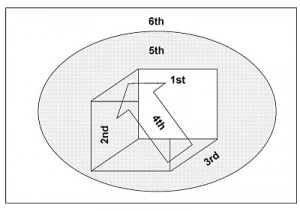HOW THE MULTI DIMENSIONAL PARADIGM BENEFITS YOU:
“A journey of 1000 miles begins with a single step” – Lao-tzu
And that is how most people start learning self-defense, they just start stepping with no idea where they are actually going.
A journey of 1000 miles actually needs to begin with a road map. The
Multi Dimensional Paradigms of Self-Defense is a “map” for the journey of learning and applying self-defense.
This journey has many forks, dead ends, and bad roads in the form of incomplete, inaccurate, and missing information.
The journey is made even more hazardous by the existence of the multiple Paradigms that self-defense experts, martial arts instructors, law enforcement, and security professionals use to promote and teach their personal view of self-defense.
These Paradigms are more than just aspects of self-defense. They are viewpoints that carry with them certain pre-conceived “truths” about what is fact and what is fiction. Unwavering belief in these “truths” create the foundation of the Paradigm and allow the Paradigm to exist without modification or evolving into a more comprehensive viewpoint.
Steadfast believers in their Paradigm will deny and refute any and all information that conflicts with their “truths”. Conflicting information or evidence threatens the “reality” of their Paradigm and are therefore ignored or attacked as “untrue”.
DIMENSIONS ARE NOT PARADIGMS
Dimensions on the other hand are not viewpoints. They are aspects or elements. These aspects are combined with the “truths” to create the Paradigms. Unlike a Paradigm, belief in one Dimension does not automatically conflict with belief in another Dimension. For example, you can believe in the existence of the color red and the color blue. But, if you believe that there is only red, then there cannot be blue.
The Dimensions are combined with the “truths” and become the foundation of the Paradigms.
1st Dimensional Paradigm of Self-Defense– This viewpoint is that self-defense is a physical confrontation between the “bad” attacker and the “good” defender. The depends upon using physical skills to defeat the attacker. The attacker is known to be bad because of his actions, or because he attacks first.
1st Dimension of Self-Defense focuses on all concepts that relate to physical combative skills, methods, and training.
More on the 1st Dimensional Paradigm
2nd Dimensional Paradigm of Self-Defense – This viewpoint acknowledges that physical defense may sometimes fail. Therefore, it is necessary to use situational awareness to avoid a potential confrontation. If avoidance fails, physical defense is applied. This paradigm also defines a “bad” attacker and a “good” defender.
2 Dimension of Self-Defense focuses on all conventional threat assessment, situational awareness, and avoidance concepts.
More on the 2nd Dimensional Paradigm
3rd Dimensional Paradigm of Self-Defense – This viewpoint builds upon the 1st and 2nd Dimensions and acknowledges that awareness and physical defense is greatly affected by the psychological and physiological responses of the combatants.
Therefore, awareness and physical defense training must include aspects that address these issues. This paradigm also defines a “bad” attacker and a good “defender”.
3rd Dimension of Self-Defense – focuses on all of the psychological, physiological, and behavioral aspects of self-defense such as scenario and adrenal stress training.
More on the 3rd Dimensional Paradigm
4th Dimensional Paradigm of Self-Defense – This viewpoint acknowledges that there are legal and ethical considerations for physical defense. It acknowledges that confrontations are not necessarily black and white with a well defined “bad” attacker and a “good” defender. There are in fact gray areas to be considered.
This viewpoint also acknowledges that sometimes physical defense requires using extreme force, and or/ pre-emptive attacks in order to defeat an opponent.
This paradigm also takes into consideration all of the aspects of the 1st, 2nd, and 3rd Dimensions.
4th Dimension of Self-Defense – focuses on all Use of Force, Rules of Engagement,legal, and ethical considerations of self-defense.
More on the 4th Dimensional Paradigm.
5th Dimensional Paradigm of Self-Defense – This viewpoint acknowledges that violence is complex issue. It is comprised of both social violence and asocial violence with large gray areas between the relative “good” and “bad” of the combatants.
This paradigm acknowledges that the driving intent and motivation of an aggressor has a great deal to due with how the aggressor is ultimately dealt with. That threat assessments, strategic, tactical, and physical responses are influenced by the specific violence dynamics of the confrontation.
5th Dimension of Self-Defense – focuses on the violence dynamics of confrontations. It incorporates these aspects of violence dynamics into all of the other four dimensions.
6th Dimensional Paradigm of Self-Defense – This viewpoint acknowledges that not only is violence comprised of the actions of the individuals involved, it is also colored by the social agendas, bias, prejudices, and conceptions of society.
This paradigm acknowledges that a person’s and societies’ view and interpretation of acts of violence can be differ widely depending upon the individual’s personal agenda and the norms and social bias of different cultures. This viewpoint also takes into consideration the concepts and aspects of the other 5 Dimensions.
6th Dimension of Self-Defense – focuses on the societal dynamics of violence. It also incorporates these aspects into all of the other five dimensions.
More on the 6th Dimensional Paradigm

Fear Management vs. Danger Management – Marc MacYoung
[…] 2. This is a 3rd Dimensional category (Psychology, Physiology, Behavioral) in terms of the Multi-Dimensional Paradigms of Self-Defense […]